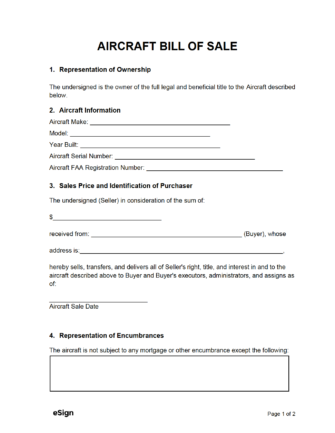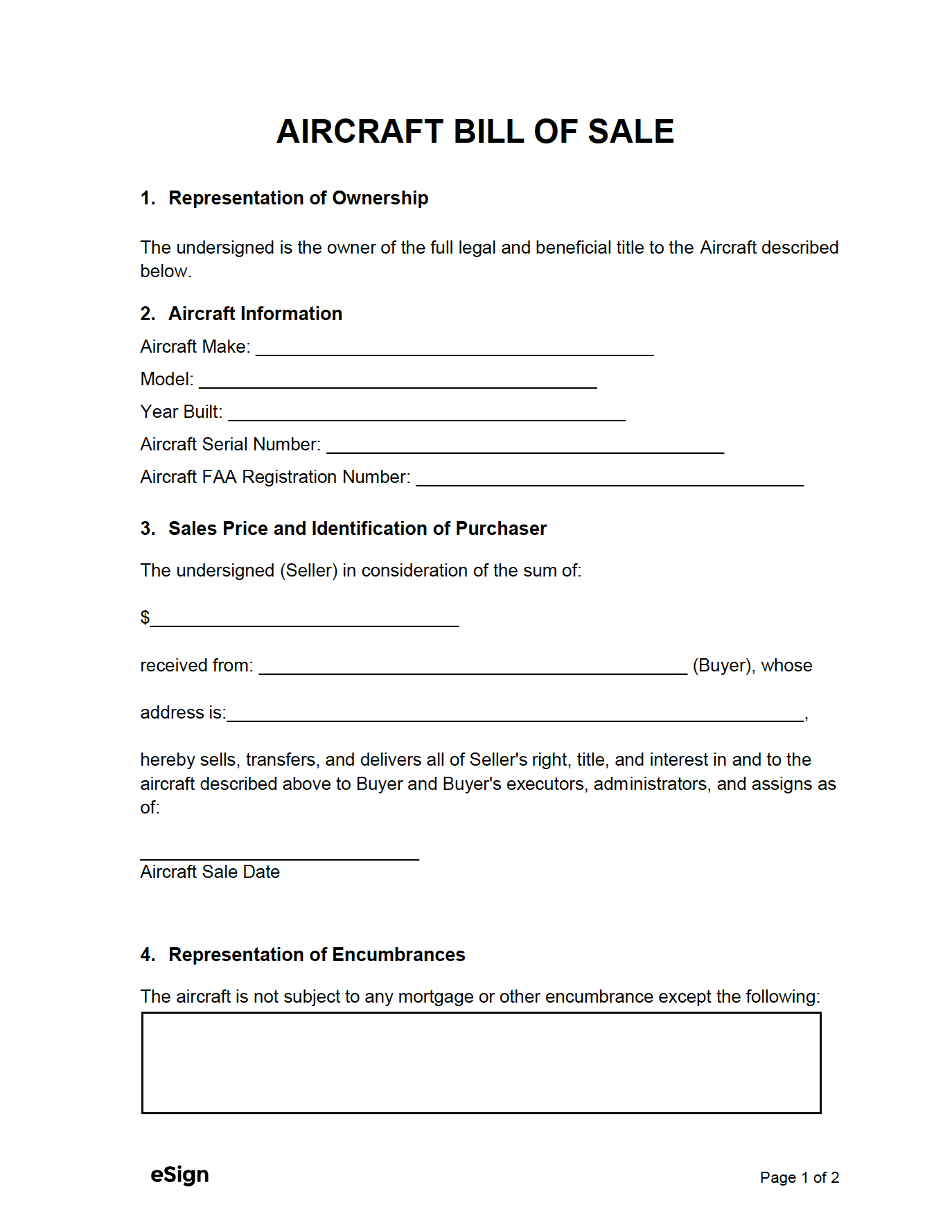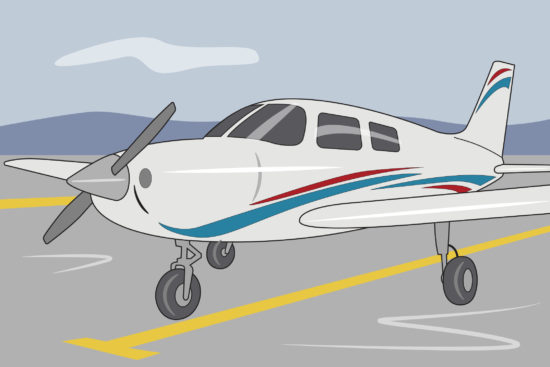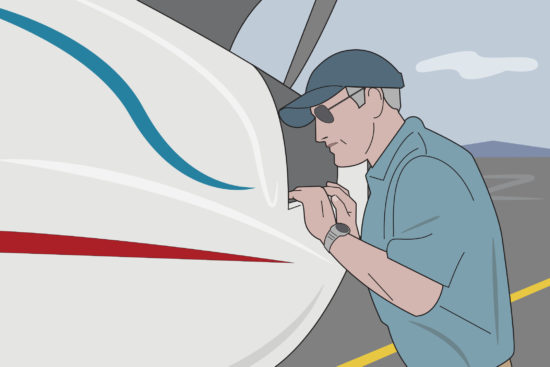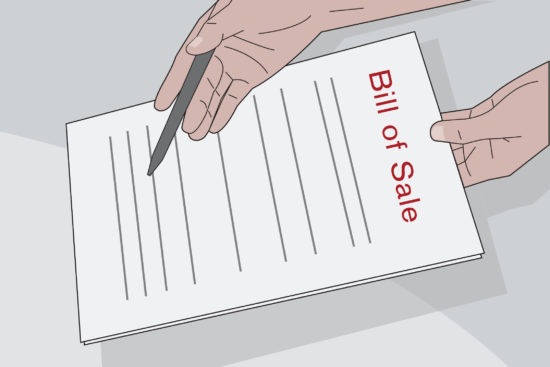An aircraft/plane bill of sale is a document used for facilitating the sale of a non-commercial, civilian-owned plane. It proves the buyer paid a sum of money in exchange for ownership rights to the aircraft. The ownership rights conveyed in a bill of sale are a requirement for registering the aircraft, which the buyer will need to complete after the transaction has been finalized.
Contents |
Sample
Download: PDF, Word (.docx), OpenDocument
AIRCRAFT BILL OF SALE
1. THE PARTIES. This agreement has been entered into on [MM/DD/YYYY] by and between [BUYER NAME] (the “Buyer”) with a mailing address of [BUYER ADDRESS] and [SELLER NAME] (the “Seller”) with a mailing address of [SELLER ADDRESS].
2. AIRCRAFT INFORMATION.
| Aircraft Make | Model | Year | Serial # | FAA Reg. # |
| [MAKE] | [MODEL] | [YYYY] | [SERIAL #] | [REG #] |
3. SALES PRICE. The Seller, in consideration for the sum of $[PURCHASE PRICE] received from the Buyer, hereby sells, transfers, and delivers all of the Seller’s rights, title, and interests in and to the aircraft described above to the Buyer.
4. REPRESENTATION OF ENCUMBRANCES.
The aircraft is not subject to any mortgage or other encumbrance except the following: [LIST MORTGAGE / ENCUMBRANCES (IF ANY)].
5. SIGNATURES.
The Buyer accepts receipt of this Bill of Sale and understands that the above Aircraft is sold in “as is” condition with no guarantees or warranties (other than any remaining factory warranty), either expressed or implied, for the Aircraft.
IN WITNESS THEREOF, the Buyer and Seller agree on the terms herein contained in this Bill of Sale.
Buyer Signature: _________________________ Date: [MM/DD/YYYY]
Printed Name: [BUYER NAME]
Seller Signature: _________________________ Date: [MM/DD/YYYY]
Printed Name: [SELLER NAME]
How to Sell an Airplane
The following are the steps involved in selling a civilian-owned fixed-wing or rotorcraft aircraft:
Step 1 – Determine the Plane’s Value
There are many variables that go into the pricing of a used aircraft. Similar to how the mileage on a vehicle is only one aspect of its condition, the number of flight hours a plane has doesn’t come close to painting the full picture of its value. Some of the factors that go into pricing a plane include the following:
- Engine hours – More engine hours, especially if the engine is close to needing its scheduled maintenance, will bring down the overall price of the aircraft.
- Maintenance records – A well-kept airplane will almost always have records pointing to the scheduled services it has received.
- Equipment/technology – Older planes may have outdated tech or features that need updating. While this isn’t always the case, planes that have had upgrades will almost always see a rise in their value.
- Airworthiness directives – These can be thought of as “recalls” for an airplane. Although instead of being issued by the manufacturer, they are issued by the FAA. The directives are known issues with the safety of the plane that needs to be corrected in order to be considered airworthy. If a plane has any outstanding directives, this will lower the plane’s value.
- The market – A “buyers” or “sellers” market is a major factor in what a plane will sell for. If planes are in great demand (or more specifically, if the make and model are in great demand), the seller can expect to sell their aircraft for a much higher price.
For plane owners that aren’t experienced in the process of selling, it is recommended that they seek assistance from a seasoned airplane appraiser. According to the Aircraft Owners and Pilots Association, there are three (3) types of appraisal of varying intensity, as listed below.
- Pricing Digest Valuation – This includes the “VREF” Aircraft value reference tool, which is an online tool that allows owners to enter the airplane manufacturer, model, year, and other factors to obtain a general “ballpark” value for their aircraft. Cost: Free
- Desktop Appraisal – This is a hired service that is done by an actual appraiser. Although the appraiser doesn’t view the aircraft in person, they will analyze current market data and will factor in any aftermarket upgrades done to the plane. Cost: ~$500-600
- Physical (in-person) Appraisal – Similar to an actual pre-purchase inspection, a physical appraisal takes into account every conceivable factor relating to the airplane’s value. This type of appraisal is suggested for those that have unique aircraft or are selling exceptionally valuable airplanes (e.g., private jets). Cost: ~$2,000-3,000.
Step 2 – Use a Broker / List Online
Because there’s no generally recognized certification for brokers of aircraft, a broker should have significant experience and an exceptional sales history. The following is a great quote from Flying Magazine:
“Deciding not to work with a broker is a little like walking into a courtroom without an attorney. You can do it, but it isn’t necessarily wise.”
When interviewing a potential broker, it’s important to ask them questions relating to their methods of marketing the aircraft online, their qualifications in general, what their reach is (if you could sell the plane in another country, for example), if they’ve sold planes similar to yours, if they have experience working with any of your favorite lawyers/escrow agents, their method of accepting payment, the average time length for selling an airplane, and so on.
If the seller is interested in selling the aircraft on their own, popular online aircraft marketplaces include:
Step 3 – Negotiate the Price / Inspection
Once a prospective buyer has been found, negotiations will begin. If the buyer is seriously interested in purchasing, they will most likely request a pre-purchase inspection for the aircraft. Depending on the thoroughness of the inspection and the size of the plane, this can take anywhere from one (1) to several hours.
Step 4 – Receive Funds & Complete the Bill of Sale
Because the bill of sale is a confirmation of the sale (and shows ownership), it should only be signed after the buyer has transferred the funds to the seller. However, the seller can complete the bill of sale ahead of time to make the signing process faster. To ensure the bill of sale can be used by the buyer for registration purposes, it should contain the following key components:
- The names and addresses of the buyer and seller.
- If the aircraft is bought from a dealer, the dealer’s certificate number (#).
- The aircraft’s registration number (#).
- The full purchase price ($) of the aircraft.
- The manufacturer, model, and serial number (#) of the aircraft.
- The full date of the transaction.
- The signatures of the seller and buyer(s).
Once the seller has received the funds in full for the agreed-upon purchase price, the parties should sit down and sign the contract. The buyer should be given the original bill of sale and an additional copy (for registering). The seller can make an additional copy for themselves if they so choose.
It is not a requirement of the FAA to have the bill of sale notarized. However, it may be required by the state in which the aircraft is being sold. Additionally, having the bill of sale notarized adds legitimacy to the contract.
Step 5 – Transfer the Aircraft
Once the aircraft has been successfully sold, the seller will need to do the following:
- Take the aircraft’s registration, complete the fields pertaining to selling, and mail it to the FAA. Note: The buyer will need to obtain a new registration by mailing AC Form 8050-1.pdf to the FAA’s office in Oklahoma.
- Remove the aircraft’s insurance.
- If the seller has an FCC radio license in the aircraft, this should be removed.
- Finally, the new owner should be provided with all of the logbooks and records regarding the aircraft. It’s important they have this to understand when the aircraft will need future scheduled maintenance.
